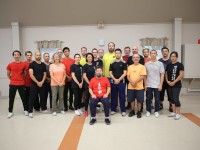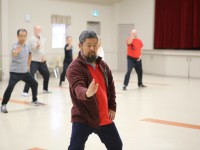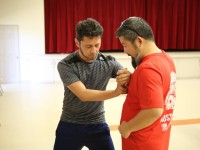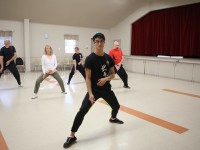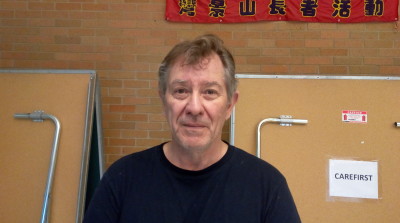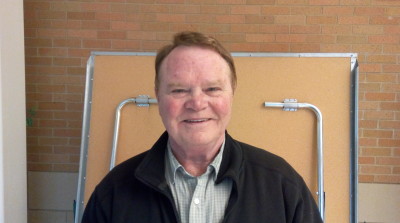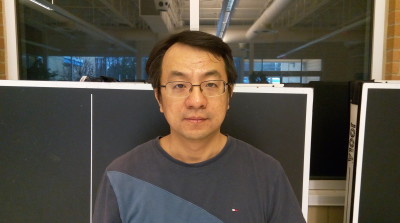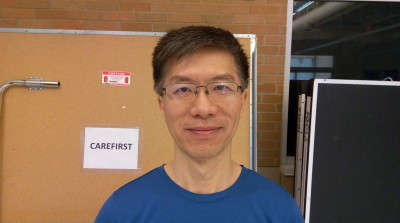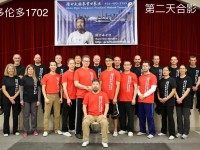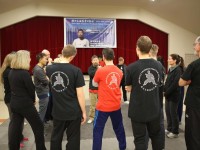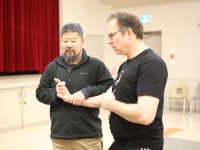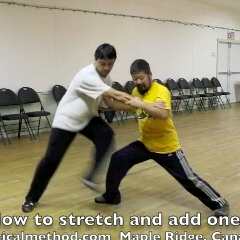We have always been told by Master Chen not to push, not to move the hand. If that is the case, what can we do?
Read more

Thank you for Rachelle Bergeron and James Tam for organizing the Ottawa workshop and their hospitality. It was always great fun to attend the Ottawa workshop. A lot of important aspects of Practical Method was shown and covered by Master Chen Zhonghua.
What is Practical Method about?
Practical Method was based on a fight system from long time again. It is an exercise we do to pass along the tradition.
What is a Practical Method stretch?
It is something with a moving and non-moving part.
Read more
Recently, I understand more about the statement:
“Rotation is the result of linear movements.”
Our actions are like on the tangent of a circle. The non-moving dot is the centre of the circle. Every linear action is very small. The direction changes all the time. The sequence of such actions along with non-moving dot cause the rotation. The actions are continued on top of each other, and they have a relationship with the non-moving dot. In the form, it is like dragging the flesh around some non-moving rod or dot. It is almost like someone pushes the arm on one side for elbow in, and someone else pushes the other side of the arm for hand out. This is related to the stretch that Master Chen Zhonghua showed on the inside or outside of the forearm. Another example is that if someone touches me in the front, I don’t move the front, but I stretch the back over or around that non-moving front.
Read more
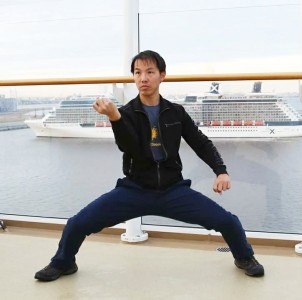 Yi (intent) is not just a thought. In my current understanding, yi describes an ability for your body to do a precise action as you command it to do. In other words, your body listens to your brain. It takes training to get to that state. Master Chen Zhonghua has said before, “the real intent is no intent”. Think about riding a bike as an example. After you have learned how to ride a bike, you don’t think about how to coordinate your hands and feet, how to balance, you only think about where to want to go. You appear to be able to do it with ease. For taijiquan, we need to train long enough to make an action habitual, so that we don’t think about it when we need it, and it just comes out.
Yi (intent) is not just a thought. In my current understanding, yi describes an ability for your body to do a precise action as you command it to do. In other words, your body listens to your brain. It takes training to get to that state. Master Chen Zhonghua has said before, “the real intent is no intent”. Think about riding a bike as an example. After you have learned how to ride a bike, you don’t think about how to coordinate your hands and feet, how to balance, you only think about where to want to go. You appear to be able to do it with ease. For taijiquan, we need to train long enough to make an action habitual, so that we don’t think about it when we need it, and it just comes out.
Read more
Related Article: http://practicalmethod.com/2014/07/triangle_double_lock_single_lock/
This video describes in taiji what we do is equal and opposite to the result we desire.
Read more
Fist covering hand downwards and Forward double push hands- Toronto North York Taiji Class on August 10, 2017 i
Fist covering hand downwards
Stretch right hand from elbow – straight forward, pull back towards left. Left hand covers the right arm, circle the elbow, stretch right arm while placing left hand middle of chest(thumb near chest), rotate the hip towards left stretching all the way while locking right elbow and shoulder.
Drop both hands on the side.
Double negative circle- right hand near the face -left hand straight-left hand palm up drop just above right knee making fist- right hand make a fist- stretch downwards just above right knee – make a fist left hand and stretch opposite side opening the Kua towards the left. All one move
The lock is on right side and the stretch from the hip is towards the left.
Forward double push hands
Right hand positive circle start with elbow in out with hand 2nd positive circle elbow in touch the elbow to right side, lock and rotate torso to left as much as possible
Open left foot using the heel, lock the left side
Step forward pulling right foot ret on toes
Right hand forward, palm up, slightly bend the elbow, left hand palm up and beside the elbow
Step the right foot out 90 degrees lock right side, pull the left foot and place it beside right foot hands placed in front of the body… double push hands, palm facing downwards, chest height.
Fist Draping Over Body (Pi Shen Chui) and Lean with Back (Bei Zhe Kao) Toronto North York Taiji Class on July 13, 2017 i
Fist Draping Over Body (Pi Shen Chui) and Lean with Back (Bei Zhe Kao)
Double negative circle: Left hand negative circle, right hand elbow in place hand in punch form just above the left knee, right hand negative elbow in place hand in punch form just above the left knee. Repeat twice.
Right arm turn clockwise and raise the arm to crown. Hand in punch form. Left hand rests on the Kua and stretch open. The line and the stretches should be from left heel to right
Cross Hands (Shi Zi Shou)
Double negative circle, left arm stretched on left side and right arm stretched on the right side higher than left arm, Continue the negative brining arms in a cross position, right above the left, hands in punch form, opposite to the chest, elbows tucked and facing the ground, same time slide right foot heel first to the right and land.
Buddha’s Warrior Attendant Pounds Mortar (Jin Gang Dao Dui) Toronto North York Taiji Class on April 20, 2017 i
Buddha’s Warrior Attendant Pounds Mortar (Jin Gang Dao Dui) Toronto North York Taiji Class on April 20, 2017
Right turn palm motor. Positive and negative circle at the same time. Close left feet. Finish with left turn palm motor
Wade Forward in Twist Steps (Qian Tang Ao Bu) Toronto North York Taiji Class on April 13, 2017
Open left leg stretch arms open as if going through a canal. Left arm cross the right arm while left leg pull up.
Lean left leg on toes and rest ->
Land left leg on the heel with toes up. Rotate the left fixed knee-heel-toes triangle on the heel to land the toes.
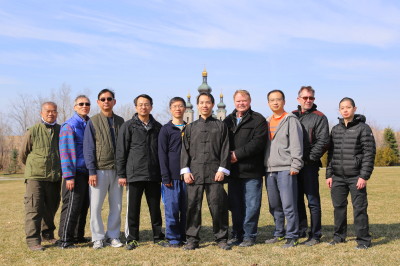
Left to Right:Dominic Lo, Ken Fong, Eric Foo, Kevin Sun, Lucas Lu, Kelvin Ho, Bruce Robinson, Peter Li, Mark Hanley, Patrick Kuo
Read more

Location: Vine Cliff Park – Vine Cliff Blvd and Hazelton Ave.
Date: Apr 9, 2017
Time: 8 am – 10:30 am
Instructor: Kelvin Ho
Fee: Free and open to public
If it rains that day, the event location will be moved to:
Bayview Hill Community Centre (open area near the pool)
114 Spadina Rd, Richmond Hill, ON L4B 2Y9
This open class is an event to pre-celebrate World Taiji Day, which will be on Apr 29, 2017. It welcomes anyone interested in learning tai chi. It will let participants experience a typical class, which includes foundations, form and push hands.
See you there!
Registration is recommended, please contact Kelvin Ho by emailing kelvin.ho@practicalmethod.ca or texting 647-738-8384.
fetching water,
– you must be in front bow stance with weight on front
– back hand open on belly
– front arm down open hand to thigh
– move front KWA out as the only movement – when front arm moves bring elbow to body
Kelvin ho had us doing this foundation exercise today. Issues I had around the move that I experienced
1. Moving shoulders ( I needed to press down first, move the kwa and capture the internal movement to go across my belly rather than up to my back shoulder)
Kelvin indicated that once stretched I should hold it for a minute or two to help loosen the kwa.
2. Moving front hands and arms independently ( the kwa works like a lever attached to the rope and pail gathering well water; when the rope moves back and forth so does the pail) the hands and arm cannot move independently
3. stance too high , I needed to perform the above in a lower stance
Watching the teacher during practice sessions
In the beginning I used to observer my teacher’s external form. Where is his hands, the right or left moves first, what’s the next move, how high is his hands. Then I learned to observe beyond the physical form. Where is the weight, his focus, which parts of his body he is locking and releasing, path of movement and connection, parts that are strong and relaxed. How the weight is counterbalanced with hands out stretched, or leaning forward/backward.
Then Self-reflection and assessment is key. Understanding how the body works and moves. Physical appearance: grounding, stretching out, grounding more while expending to maintain balance.
Why we shift weight and settle into posture by dropping weight. – My observation of my teacher- dropping weight grounds the body and creates effectiveness. I.e. stepping into opponent’s space- weight forward – settling into pose, structure and weight drop to create effectiveness.
Toronto North York Taiji Class on March 30, 2017
3 steps
Half horse stance posture
Bring right hand 45 degree palm up – Just above the left thigh
Bring left hand near right hand 45 degree palm up, elbows touching in a straight line Pull elbows to dantian at the same time bringing left foot (with toes) in beside the right foot. Rest the heel of the foot. All should be one action, like a bullet.
Things to check.
- Keep hands straight and locked at all times
- Keep back straight and lock the right side. Imagine there is a bar from back of right shoulder to right heel.
Review of Positive circle
-elbow in do not move hand or wrist
– twist waist without moving hips
– hand out do not move elbow
– do not move off the finger line to the exact spot on the opponent
starting in front bow stance after bringing in my elbow, I found that when I twisted my waist my weight moved off the front foot. Kelvin Ho corrected this by calling out when my weight incorrectly changed from my front foot. The twisting of the waist helps bring the elbow to the centerline. It requires a lot of focus to keep the fingers leading when going out torqueing the arm while not letting the elbow get away and keeping it down.
Kelvin Ho was invited to perform taijiquan during multi-cultural week at Sir Wilfrid Laurier Public School on Mar. 23, 2017.
- Kelvin Ho corrected me on proper formation & alignment of tile hand (palm) which I find has helped me considerably whilst performing both the negative and positive arm circles
- In addition Kelvin re-iterated the concept of having a stick in the arms especially from the elbow to the finger tips and with the proper use of the aforementioned hand alignment while going out with the hand & in with the elbow, without deviation by bending at the wrist which I have been doing ,has helped a lot
- To be clear I did not believe or at least I did not think I was bending at the wrist during this process, however, he pointed out that I was indeed doing so as as a means of compensating for my inflexibility in bringing the elbow in to touch the waist in the proper spot.
- I was really pleased today that a new chap joined our class. Having just recently completed the choreography of the entire form Kelvin has at this juncture decided to return to the start of the form and systematically move sequentially forward. Now, in all probability he has explained the breakdown of the various movements using the same words he has used before (probably many times) ,however, at least in my case today, I actually understood them more clearly than ever before which I must confess made me both happy and more inspired to continue practicing
- What I found when breaking down the 1st part of the first move “Budda’s Warrior Attendent Pounds Mortar” is that when required to bring the foot in before shovelling it back out on a 45 degree angle, is that the entire core muscle groups are used to “pull” the foot in. Previously I was rising to make it easier to bring the foot in & today I was told to go lower down and activate those front/back core muscles, tendons & ligaments etc….Big difference doing it this way (properly).. to be sure.
1) Today we practiced not moving the knee forward during movements involving steping forward. Think of “stretching” hamstring and calf muscle as if knee pushing those 2 points apart (like a triangle )
Corrections in first movement when arms leads out to right after foot shovels forward-should be a positive circle leading with hand.
Also in first move as arms sweeps through to front, lead with elbow and don’t let arm or elbow drop lower.
In second movement correction was to make sure I never see my palm. Don’t turn wrist.
2) White Crane Spreads its Wings
Last week Kelvin Ho review turning flower out at bottom of sea. he posted a video and the following points
1) Maintain a non-moving vertical rod from head to left heel throughout the action.
2) Hold the right forearm in front of the chest with a fist, while the left fist is on the side of the body.
3) Throw the right fist down to the right side as hard as possible with a raising right knee to create a scissoring effect, while throwing the left fist up to the left ear.
4) There should be no tossing or turning of the body, but there is a spiral stretch along the vertical rod Read more
We worked on a few different moves in the form today. The first 3 moves required standing on one leg.
- White Ape Presents Fruit (Drilled 50 times on each side)
- Kick with Right/Left Heel
- Turning Flower out of the Bottom of the Sea
- Punch to the Groin
- Punch to the Ground
- Turn Over Body and Double Kick
1) Maintain a non-moving vertical rod from head to left heel throughout the action.
2) Hold the right forearm in front of the chest with a fist, while the left fist is on the side of the body.
3) Throw the right fist down to the right side as hard as possible with a raising right knee to create a scissoring effect, while throwing the left fist up to the left ear.
4) There should be no tossing or turning of the body, but there is a spiral stretch along the vertical rod.



